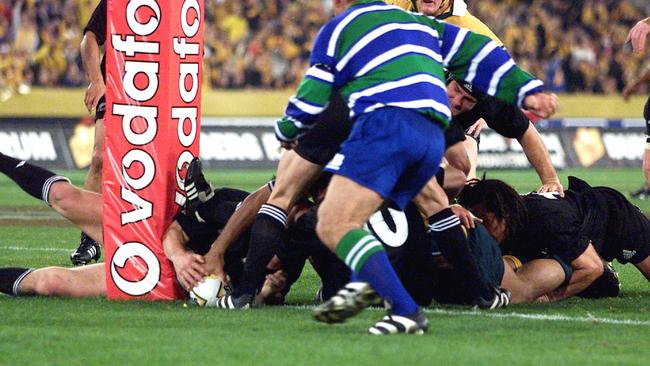World Rugby driving a wedge against meaningful law reform

Five terror-filled minutes later there is a polite knock at the door. They’ve sent a health inspector.
That is pretty much how Australian rugby felt on Wednesday when it realised that World Rugby had finally responded to its desperate plea for law changes by deciding to put an end to a practice that virtually no one was complaining about.
In short, World Rugby had decreed that tries no longer can be scored by placing the ball at the base of the uprights.
Australian fans looked at each other in bewilderment. Here was what World Rugby did best — creating a solution in search of a problem. Had placard-waving protesters been clogging the streets demanding that rugby results be overturned after a glut of outrageous tries scored by tunnellers, had Twitter been hijacked by subterranean trolls gloating that they had found a failsafe way of scoring that no defence could keep out, World Rugby’s actions might have been desperately needed. But no, there was none of that at all.
Ask Australians to nominate a match decided by a footballer placing the ball at the base of an upright and those with exceptional memories might hark back to John Eales’ last Test, back in September 2001, when Toutai Kefu wove his way through the All Blacks defence in the 79th minute to suddenly reach out for a try that gave the Wallabies a 29-26 victory. Otherwise, only vague images come to mind of Wycliff Palu doing a similar thing to Queensland at Suncorp Stadium to snatch a NSW win a few years back, but certainly nothing is screamingly obvious.
The rationale for World Rugby’s decision is that there is no way of stopping such tries, where players are effectively shielded by the pads around the upright to score. Indeed, they do not even need to get the ball across the tryline. If it is planted at the base of the post, that is all the referee needs.
Certainly the modern-day trend to bulky goalpost pads — all the better to get your advertising message across — has made this trend of scoring in this fashion all the more prevalent. Yet of all the groups in this country who are working towards laws that will improve the game, the Barry Honan group, the four Super Rugby coaches, the two blokes in the bar bouncing suggestions around from the safety of a 1.5m gap …. not one has ever raised this as a problem in need of a solution.
One wonders, indeed, how World Rugby prioritises how law changes like this get fast-tracked. Mostly, potential law changes are subjected to the tedium of endless discussion, official trials, more endless discussion and even then one of the northern hemisphere powers can still come along and veto the agreed-upon answer, just as England did right at the death with many of the ELV — experimental law variations.
But occasionally, an idea will be fast-tracked. Yet if the intention was to ensure that in every instance the defence has a legitimate chance to stop a try being scored against it, why on earth did World Rugby start with such an arcane rule as the one governing tries scored at the base of goalposts? Why not start, instead, with the driving maul?
Honan’s group, which includes such key figures as Rod Macqueen, the World Cup-winning coach, and Dick Marks, the former national coaching director, has examined the driving maul in depth and made no secret of the fact their purpose is to limit it as a try-scoring weapon.
One of their suggestions has the lineout not being formed within 10m of the tryline — at present, even if the ball goes into touch very close to the cornerpost, the lineout is set 5m from the line. But the more significant factor in their proposed law is to stop the rolling maul driving forward more than 5m. So unless teams run a preliminary play to get the ball to within five metres of the tryline and only then crank up the driving maul, it is difficult to see how the maul could survive these suggested law changes.
That would, of course, seriously disadvantage teams such as the Brumbies whose head coach, Dan McKellar, insists his side’s expertise at the driving maul creates an expectation in the opposition’s mind that they always need to guard against it at lineouts close to their tryline — which leaves them wide open when the Brumbies use the maul as a diversion.
There are so many areas in which the laws are failing the game of rugby — where an early red-card totally distorts a contest, or whether an unsuccessful attempt at an intercept warrants so much as a penalty, let alone a yellow card, or the fact that defenders lined up with the last feet in a ruck are able to shut down most attacks — that World Rugby could have turned almost anywhere to look for improvements.
And yet when World Rugby moved, it chose only to tinker around the edges.



Armed killers are breaking into your house and in a frenzy you dial triple-0. “Don’t worry,” comes the reassuring voice at the end of the line, “we’ll have help sent to you in no time”.